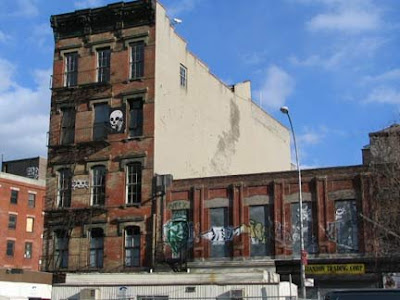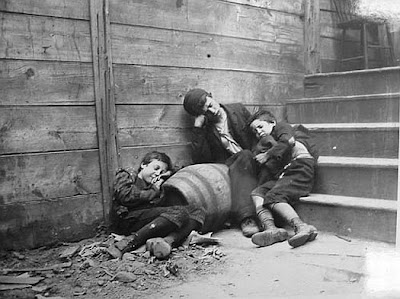In that brilliant work on the depraved and squalid life rife in Lower Manhattan in the mid to late 1800's, in all its rumbustious and physical forms, "Low Life"author, Luc Sante attests:-
"By popular accord, the very worst dive on the Bowery in the 1890's was McGurk's Suicide Hall, on the East Side just above Houston Street, and it did not conduct its business in secrecy, since it possessed one of the first electric signs on the avenue" .............Entertainment consisted of singing waiters and a small band; the customers were, as ever, mostly sailors. " It was said that his business card reached every sailor in the world"
The Hall (above at 295, The Bowery) owned by a John McGurk, got its name because the conditions were so bad that its female employee's (and contract workers) resorted to on-the-job suicides. In 1899, there were at least six, as well as more than seven attempts. The victims were mostly the prostitutes who seem to be the main reason for the Hall's existence. It was a truly desperate place: nonetheless it became a morbid tourist attraction. Indeed, John McGurk focused on these morbid and wholly unpleasant happenings in his marketing efforts.
The favoured choice for the method was containers of carbolic acid, followed often by plummeting from the balconies onto the customers partying on the floor below. Waiters came to recognize persons who might attempt suicide and formed flying wedges to eject the aggrieved parties before the deed could be attempted or completed.
McGurk eventually closed the Suicide Hall and moved to California. The building saw nothing but flophouses and ruin for the most part of the 20th. century until an artist couple took over and turned it into a workspace. They in turn were forced out by the power of gentrification. The Hall was demolished in 2005 (above) and the site has been transformed into the sleek glass condominium Avalon Bowery Place (below).
In 1892 Charles H Hoyt wrote:-
"Oh! the night that I struck New York,
I went out for a quiet walk;
Folks who are "on to" the city say,
Better by far that I took Broadway;
But I was out to enjoy the sights,
There was the Bow'ry ablaze with lights;
I had one of the devil's own nights!
I'll never go there anymore."
Perhaps he saw the electric sign outside of the Suicide Hall and ventured in?

The developer,
Avalon Communities, promises on the building's web site "
excitement around every corner". While the same claim might have been made in McGurk's day, one presumes today's excitements are of a different order and that the ghosts of women plummeting to their deaths are not a feature of this development.



















































